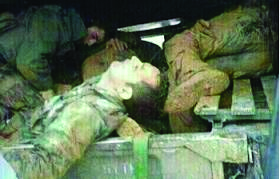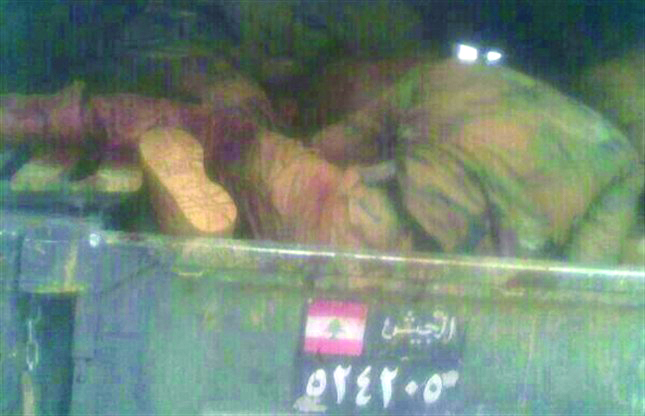February 25, 2013
 |
 |
|
The aftermath of the violence captured by cell phone videos. Here, an unknown number of soldiers wounded or killed during the Orsal clash are piled into the bed of a Lebanese Army truck. Combined with the absence of robust judicial measures that could guide the country through its current political crisis, pictures such as these are certainly disadvantages to the LAF's image. As a result, the LAF seems destined to become the weakest link in the chain of armed organizations throughout the country.
|
According to eyewitness accounts (given primarily by women who were home at the time) Khaled Humayyed was about to leave home in his Toyota pickup when he was shot and killed by men wearing civilian clothes. Uniformed army personnel who arrived in official Humvees intervened after local residents attacked the individuals who actually killed Humayyed. Some Orsal residents believe Humayyed was slain in a raid orchestrated by Hezbollah. “All of us thought they were Hezbollah, because the two cars [they arrived in] were civilian and the people who shot him were wearing civilian clothes.” For its part, Hezbollah denied any involvement in the incident. Yet if the description given by the Orsal residents is true, then instead of pursuing Humayyed the LAF may have intervened on behalf of the assassins. Based on the numerous videos posted online, however, it is clear that when they were killed, Captain Bashalani and Sergeant Zahraman were in uniform, which conflicts with the witnesses’ observations. Importantly, none of the reports that have been made public give any indication of the fate of those who actually killed Humayyed.
Rather than clarifying the incident, however, the LAF and the Lebanese Army’s Directorate of Intelligence (DI) clouded it even further by providing contradictory statements. DI Director General Edmond Fadel claimed Humayyed was a member of the infamous Syrian jihadist group Jabjat al-Nusra, said to be associated with elements of al-Qaeda in Iraq operating in the Orsal area. Interestingly, except for Defense Minister Fayez Ghosn, that accusation was completely unsupported by other Lebanese officials. Similarly, in an al-Monitor article published the day after the incident, journalist Jean Aziz also claimed that Jabhat al-Nusra was in Orsal. Aziz also linked Humayyed with another incident that occurred in Orsal on November 22, 2011 between the LAF and Syrian rebel factions. Of course, it should be noted that Aziz is a regular columnist for Lebanon’s al-Akhbar newspaper, which like the English-language al-Monitor, is considered by local sources to be a Hezbollah medium rather than an independent and objective source of news.
In response to the soldiers’ deaths, the LAF implemented a series of measures including the deployment of several hundred special forces personnel in and around the village. Many Sunni and pro-Syrian revolution commentators speculated that the LAF’s reaction was both an attempt to save face and a means of collectively punishing Orsal’s residents. However, LAF Chief of Staff Jean Qahwaji denied reports that the army was besieging the town, characterizing the action instead as an effort to strengthen the army’s presence near the border with Syria. Owing to the Orsal incident, protests in support of the LAF were held simultaneously in several predominatelyShia cities and villages in the south and the Bekaa.
.jpg) |
In the weeks that followed, tensions continued to mount in Orsal before they eventually peaked on Friday, February 15 when nearly 100 demonstrators blocked a road with flaming tires to protest the presence of army reinforcements. In fact, Sunni leaders have differed on how they should respond to the incident, as many of the moderate principals are hesitant about providing too much support to potential Islamists. Though former Prime Minister Saad Hariri condemned the events, he also urged Orsal residents to cooperate with the military and stressed the importance of allowing “justice to take its course and [preserving] the image of the military institution.” Prime Minister Najib Mikati, similarly reserved in his criticism of the incident, remarked that the Lebanese army enjoys political independence and stressed that the government, “completely back[s] the army and urge[s] the residents of Arsal to cooperate with it.”
Relative to the significance of Orsal, the town’s outskirts are known as the Jurd, or "hinterland," and boast the longest stretch of the Lebanese-Syrian border—approximately 50 Km—compared to any other location in Lebanon. Given Orsal’s extremely close proximity to (and enduring relationship with) the border, a number of conflicts related to the Syrian crisis have occurred there between the army and local residents. These prevailing tensions stem in part from the fact that the town hosts rebel factions and openly supports the Syrian revolution. As a result, residents generally view the LAF as a tool wielded by Hezbollah and by extension, as a State organization sympathetic to the Syrian regime—a position that runs counter to pupular sentiments in Orsal. The town’s location leaves little doubt that events in Syria have indeed impacted the community. For instance, when Syrian troops fired on the town on May 29, 2012, at least one Lebanese citizen was killed. On September 22, 2012, elements of the Free Syrian Army (FSA) entered Orsal and allegedly attacked an army post.
Nearly a week after the incident, Orsal Municipality Head Ali al-Hujairi appeared on the television show Kalam al-Nass (“Voice of the People”). During the interview, he stated that the Syrian border has become so permeable that a person could go to Damascus for lunch and return without being bothered. Surprisingly, al-Hujairi’s description of the situation failed to attract much attention, an outcome that likely resulted from the media’s (vis-à-vis the public’s) predilection for focusing on the details of the incident.
For its part, the Lebanese media, from TV stations to online blogs, unleashed a veritable maelstrom of coverage that sought to tell “the truth” about the incident. Yet with Lebanon’s penchant for keeping the details of controversial events under wraps, we will probably never know what actually happened that day in Orsal. Since then, Lebanon’s political leaders appear to have been sweeping the incident toward the judiciary. But given the country’s silent rejection of the “rule of law,” such a result would all but bury any genuine investigation, as the judicial system (particularly the Military Court) is “rug” that hides contentious issues from the public. That function become more than apparent on February 11 when Military Prosecutor Judge Saqr Saqr charged 34 individuals for their involvement in the incident, only two of which were in army custody.
Similarly, by February 15 the LAF claimed to have arrested eleven people for weapons possession (four of whom were Syrian nationals) in an incident that injured three more soldiers. According to information gleaned from sources close to the FSA, however, Orsal has never been a hub for the transfer or stockpiling of major arms. Instead, it was used as a passage area for light weapons, ammunition, aid and the treatment of FSA soldiers wounded in the fighting. Those sources also informed Shia Watch that since light weapons have become much less expensive in Syria, Orsal’s strategic importance has decreased considerably.
In general, the February 1 incident certainly exposed the positioning of LAF and FSA forces relative to Orsal, such that the LAF has occupied one side of the Lebanese-Syrian border while the FSA sits just across the way in Syria. Under existing circumstances, the situation can have only two logical outcomes. First, clashes will occur between the LAF and the FSA. That violence will force Lebanon’s hand relative to recognizing the FSA’s presence, as the LAF is dealing with armed organizations aside from the regular Syrian army. In such a case, the FSA would likely make a political decision aimed at forcing a Lebanese response. The second, more likely scenario is that the “status quo” in which the LAF turns a blind eye to “tolerable” FSA and Lebanese activities occurring along the border would remain in effect. Sources close to the FSA also advised ShiaWatch that while the organization believes it could score a political victory by pressuring the LAF, it is more interested in seeing the border area around Orsal remain porous. Further, the FSA believes that any political motivation for inciting clashes with the LAF could be easily overlooked, fail to garner the anticipated widespread, positive attention or even draw the ire of Western powers. It must be kept in mind, of course, that the United States serves as the LAF’s primary benefactor, with some European countries providing assistance as well.
Finally, the events in Orsal have again highlighted the need not only for Lebanon’s government, but also for domestic and foreign observers to keep close watch on the border region. Although Orsal itself may be spared the ignominious and unfortunate “honor” of hosting pitched battles between the LAF and FSA, the latter continues to operate along other sections of the border that are under Hezbollah control—an avowed supporter of the Syrian regime. For instance, areas north of Orsal near the city of Hermel experienced significant clashes as recently as February 17, when at least three Hezbollah fighters were reportedly killed during border clashes with Syrian rebel factions. During the clashes in Lebanese villages virtually surrounded by twenty or so Syrian villages, Hezbollah fighters had occupied Lebanese Shia homes abandoned during previous conflicts. Surprisingly, a Hezbollah official admitted to Agence France-Presse that “two Lebanese Shiites living in Syria were killed and 14 others wounded in clashes with rebels.” The official obfuscated the remark, however, by saying that the Shia were killed in self-defense. Further, the FSA warned on February 20 that should Hezbollah maintain its presence in Syrian territory, the FSA would hit targets in Lebanon. “If Hezbollah does not stop shelling Syrian territories, villages, and unarmed civilians from inside Lebanese territory within 48 hours, we will respond with our arms to the sources of its fire and silence them inside Lebanese territory.” Clearly, rather than instigate any act that could cause a closing of the border, the FSA—at least at this point—is content to highlight Hezbollah’s enduring participation in the Syrian crisis.
The fact remains, however, that the Lebanese-Syrian border is a war zone. The stretch of border that extends from al-Qaa to Orsal is experiencing a “cold war” based on the will of the players involved and its geographic location. In contrast, the Hezbollah-controlled portion of the border north of the al-Qaa-Orsal line is enduring particularly “heated” combat. There, armed clashes occur frequently despite Hezbollah’s continued claim that it is not involved in the Syrian crisis. Even Ali Abdel-Karim Ali, Syria’s ambassador to Lebanon has denied any involvement by Hezbollah and characterized any claim to the contrary as “refutable.” Clearly, the foregoing should reiterate the applicability of certain clauses in United Nations Security Council Resolution 1701, which helped restore calm to South Lebanon by ending hostilities between Hezbollah and Israel in 2006. Importantly, that resolution foresaw the importance of securing Lebanon’s border areas.
----------------------------------------------------
Kelly Stedem contributed to this article
----------------------------------------------------
Kelly Stedem contributed to this article
----------------------------------------------------

 Print
Print Share
Share